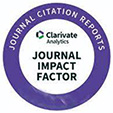CHEMICAL TRANSFORMATION OF EUGENOL ISOLATED FROM CLOVE OIL TO 4-ALLYL-2-METHOXY-6-SULFONICPHENOL AND 4-ALLYL-2-METHOXY-6-AMINOPHENOL
I Made Sudarma(1*), Maria Ulfa(2), Sarkono Sarkono(3)
(1) Chemistry Laboratory, Faculty of Science University of Mataram Jl. Majapahit 62 Mataram 83125 Indonesia
(2) Chemistry Laboratory, Faculty of Science University of Mataram Jl. Majapahit 62 Mataram 83125 Indonesia
(3) Chemistry Laboratory, Faculty of Science University of Mataram Jl. Majapahit 62 Mataram 83125 Indonesia
(*) Corresponding Author
Abstract
The overall objective of this research was to develop new compounds with potential biological activity from readily accessed natural products, in particular eugenol. Eugenol has been reported to posses antioxidant and anticancer properties. In an attempt to enhance intrinsic activity of this natural compound, some derivatives were possible to synthesize. The main aim of this preliminary research was to isolate eugenol from clove oil and made its sulfonic and amine derivatives through chemical transformation. Clove oil was extracted from clove buds with dichloromethane and followed by isolation of eugenol using column chromatography to afford eugenol (73%). Eugenol has been reported to posses antioxidant and anticancer properties. In an attempt to enhance intrinsic activity of this natural compound, some derivatives were possible to synthesize. Eugenol was transformed to its sulfonic derivative in moderate yield by treatment with chlorosulfonic acid and to its amine by reduction of its nitro derivative. This transformation was rapidly confirmed by GC-MS analysis which showed significance molecular ion at m/z 244 corresponding to molecular formula C10H12SO5. and at m/z 179 corresponding to molecular formula C10H11O2NH2.
Keywords
Full Text:
Full Text PDFReferences
[1] http://en.wikipedia.org/wiki/Clove
[2] Burt, S.A. dan Reinder, R.D., 2003, Lett. Appl. Microbiol., 36, 3, 162-167.
[3] Kim, S.I., Yi, J.H., and Tak, J.H., 2004, Vet. Parasitol, 120, 4, 297–304.
[4] Li, Y., Xu, C., and Zhang, Q., 2005, J. Ethnopharmacol., 4-26-2005, 98,3, 329–333.
[5] Pisano, M., Pagnan, G., and Loi, M., 2007, Molecular Cancer, 2007, 6, 8.
[6] http://www.nlm.nih.gov/medlineplus/druginfo/natural/patient-clove.html.
[7] H. Carrasco A., L. Espinoza C., Cardile, V., Gallardo, C., Cardona, W., Lombardo, L., K. Catalán M., M. Cuellar F, and Russo, A., 2008, J. Braz. Chem. Soc., 19, 3, 543–548.
[8] Sudarma, I.M., Ulfa, M., and Sarkono, 2009, Indo. J. Chem., 9, 1, 84-88.
Article Metrics
Copyright (c) 2010 Indonesian Journal of Chemistry

This work is licensed under a Creative Commons Attribution-NonCommercial-NoDerivatives 4.0 International License.
Indonesian Journal of Chemistry (ISSN 1411-9420 /e-ISSN 2460-1578) - Chemistry Department, Universitas Gadjah Mada, Indonesia.












